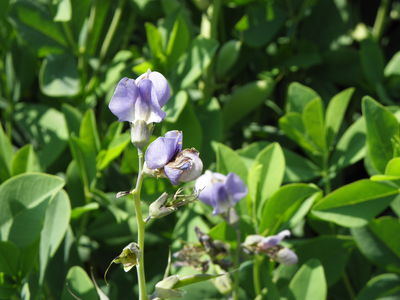Legumes of the World. Edited by G. Lewis, B. Schrire, B. MacKinder & M. Lock. Royal Botanic Gardens, Kew. (2005)
-
Note
-
Traditionally, the small tribe Thermopsideae includes six genera with a total of (43)–45–(46) species scattered through the mediterranean and temperate regions of N America, the Mediterranean Basin, and C to NE Asia (Turner, 1981). Recent molecular data, however, now places Pickeringia within the Cladrastis-Styphnolobium clade in the basal Papilionoideae (Wojciechowski et al., 2004). Thermopsis itself occurs in both N America and E Asia, and Baptisia is exclusively N American. The two species of Anagyris occur around the Mediterranean Basin and in Macaronesia. Piptanthus and Ammopiptanthus occur in E Asia. The tribe as a whole is absent from the S Hemisphere. The free stamens have always marked the tribe as distinct, and have led some to associate it with Sophoreae. Its earliest placement (e.g., Bentham, 1865) was in his Podalyrieae, in which he included Cyclopia and Podalyria, as well as many genera now placed in Mirbelieae. However, anatomical and phytochemical work (summarised by Turner, 1981) points to a closer relationship with Genisteae.
Molecular analyses (e.g., Pennington et al., 2001; Kajita et al., 2001; Wojciechowski, 2003) and studies combining molecular and phytochemical data (e.g., Käss & Wink, 1995; Wink & Mohamed, 2003), all associated Thermopsideae with Genisteae, and placed them as part of the ‘core genistoids’ (Thermopsideae, Sophoreae sens. strict., Euchresteae, Podalyrieae, Crotalarieae and Genisteae). The Thermopsideae form a clade sister to Sophoreae sens. strict. in some analyses (e.g., Crisp et al., 2000 [where Thermopsideae is strongly supported as monophyletic] and Wink & Mohamed, 2003). In other analyses, however, a monophyletic Thermopsideae is not supported (e.g., Käss & Wink, 1995; Kajita et al., 2001; Wojciechowski et al., 2004). In the latter analysis elements of the tribe are nested separately within a paraphyletic Sophoreae sens. strict. The combined Sophoreae sens. strict.-Thermopsideae clade is sister to a Podalyrieae- Crotalarieae-Genisteae clade. Ammopiptanthus does not appear to have been sequenced to date and its placement here is based on comments by Turner (1981). A recircumscribed Thermopsideae, excluding Pickeringia (Fig. 34), thus requires further study to ascertain its tribal composition and validity.
Interspecific hybridisation is common
-
Habit
-
Herbs
-
Ecology
-
Continental and warm temperate grassland and open woodland, along streams and in sandy or rocky areas
-
Distribution
-
E (SE coastal plain) and C USA (SC States to slightly adjacent Canada)






